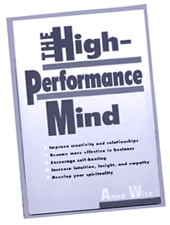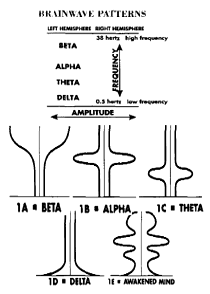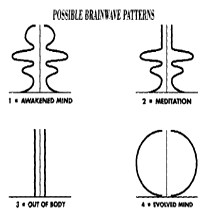| |

By Sister Initiate Dianna Roberts,
Houston, Texas, U.S.A .
(Originally In English)
 by Anna Wise, 1995, Jeremy P. Tarcher/Putnam, New York, NY, U.S.A. |
![]() Everyone
can develop greater creativity, improve relationships, experience heightened
mental clarity, better manage stress, encourage emotional and physical health,
and profoundly deepen spirituality by evaluating his or her current brain
wave patterns and then developing those that correspond to optimum states
of mind. That is the premise of The High Performance Mind. The method proposed
in this book, the result of Anna Wise's continuation of the work she began
under the guidance of the late C. Maxwell Cade, an eminent British psycho-biologist
in the mid-1970's, is a fusion of meditation and technology.
Everyone
can develop greater creativity, improve relationships, experience heightened
mental clarity, better manage stress, encourage emotional and physical health,
and profoundly deepen spirituality by evaluating his or her current brain
wave patterns and then developing those that correspond to optimum states
of mind. That is the premise of The High Performance Mind. The method proposed
in this book, the result of Anna Wise's continuation of the work she began
under the guidance of the late C. Maxwell Cade, an eminent British psycho-biologist
in the mid-1970's, is a fusion of meditation and technology.
![]() First,
she shows that the frequencies of electrical impulses in the brain's "brain
waves", which can be measured by specially modified electroencephalograph
(EEG) machines, can be shown to correlate with certain inner states. Brain
waves are divided into types on the basis of their frequencies as shown in
drawings in the book.
First,
she shows that the frequencies of electrical impulses in the brain's "brain
waves", which can be measured by specially modified electroencephalograph
(EEG) machines, can be shown to correlate with certain inner states. Brain
waves are divided into types on the basis of their frequencies as shown in
drawings in the book.
![]() The highest
frequency brain waves, beta waves, are associated with the active, conscious
state of mind involved in mental processes and logical thinking. The next
highest, alpha waves, are associated with daydreaming and visualization (or
"sensualization", as the author puts it) and with relaxed, detached
awareness, a receptive state of mind. They also, very importantly, serve as
a bridge between the conscious and unconscious minds or between the beta mind
state and those states associated with the lower frequency brain waves.
The highest
frequency brain waves, beta waves, are associated with the active, conscious
state of mind involved in mental processes and logical thinking. The next
highest, alpha waves, are associated with daydreaming and visualization (or
"sensualization", as the author puts it) and with relaxed, detached
awareness, a receptive state of mind. They also, very importantly, serve as
a bridge between the conscious and unconscious minds or between the beta mind
state and those states associated with the lower frequency brain waves.
![]() Theta
waves are next in frequency below alpha waves and are associated with the
subconscious, the boundary zone between the conscious and unconscious minds,
the home of various memories, sensations, and emotions that may be inaccessible
to our conscious minds but nonetheless deeply affect our attitudes, beliefs,
and behaviors. Theta states can be reservoirs of creativity and inspiration.
Theta
waves are next in frequency below alpha waves and are associated with the
subconscious, the boundary zone between the conscious and unconscious minds,
the home of various memories, sensations, and emotions that may be inaccessible
to our conscious minds but nonetheless deeply affect our attitudes, beliefs,
and behaviors. Theta states can be reservoirs of creativity and inspiration.
![]() Delta
brain waves are those with the lowest frequencies and relate to the unconscious
mind. Delta waves are present during deep sleep, even when the other types
of brain waves are not detectable, but they may also be present in the waking
state, combined with the other types. They are associated with highly instinctive,
intuitive, and empathetic states of mind.
Delta
brain waves are those with the lowest frequencies and relate to the unconscious
mind. Delta waves are present during deep sleep, even when the other types
of brain waves are not detectable, but they may also be present in the waking
state, combined with the other types. They are associated with highly instinctive,
intuitive, and empathetic states of mind.
|
![]() Wise
points out that no one category of brain waves is "better" than
the others, but that, like the musical notes in a symphony, their combination
can produce discord or harmonious, flowing, beautiful mental music. The goal
is the "awakened" brain wave pattern (see picture 1-E) in which
one produces beta, alpha, theta, and delta waves together in the right proportions
and relationships with each other. Then, one experiences the intuitive, empathetic
state of the delta waves; the creative inspiration, insight, and spiritual
awareness of the theta waves; the bridging capacity and relaxed, detached
awareness of the alpha waves; and the conscious processing of the beta waves,
all at the same time.
Wise
points out that no one category of brain waves is "better" than
the others, but that, like the musical notes in a symphony, their combination
can produce discord or harmonious, flowing, beautiful mental music. The goal
is the "awakened" brain wave pattern (see picture 1-E) in which
one produces beta, alpha, theta, and delta waves together in the right proportions
and relationships with each other. Then, one experiences the intuitive, empathetic
state of the delta waves; the creative inspiration, insight, and spiritual
awareness of the theta waves; the bridging capacity and relaxed, detached
awareness of the alpha waves; and the conscious processing of the beta waves,
all at the same time.
![]() The author
draws from her many years as a therapist and meditation teacher to give examples
of drawings of brain wave patterns accompanied by descriptions of what the
subjects, who ranged from meditation novices to highly evolved practitioners,
were experiencing at the time the measurements were being made. Many of the
meditative experiences described in the book will be familiar to Quan Yin
practitioners, and specific guidelines are given so that one can relate these
inner experiences to one's own likely brain wave patterns.
The author
draws from her many years as a therapist and meditation teacher to give examples
of drawings of brain wave patterns accompanied by descriptions of what the
subjects, who ranged from meditation novices to highly evolved practitioners,
were experiencing at the time the measurements were being made. Many of the
meditative experiences described in the book will be familiar to Quan Yin
practitioners, and specific guidelines are given so that one can relate these
inner experiences to one's own likely brain wave patterns.
![]() For instance, a few of the many
subjective landmarks listed, ranging from mostly continuous beta brain waves
to balanced awakened and evolved brain wave patterns include: difficulty stilling
the mind; an itchy, distractible, inattentive state; a sensation of drifting
off to or being pulled back from sleep; intermittent, uninvited vivid flashes
of imagery; pleasant sensations of floating or lightness; longer-lasting and
clearer imagery; feelings of loss of bodily boundaries; very lucid states
of consciousness; feelings of deep satisfaction; intense alertness, calmness,
and detachment; novel intuitive insight into problems; sensations of being
surrounded by light; feelings of higher spiritual awareness; experiences of
bliss/indefinable peace; and a feeling of greater knowledge of the universe.
For instance, a few of the many
subjective landmarks listed, ranging from mostly continuous beta brain waves
to balanced awakened and evolved brain wave patterns include: difficulty stilling
the mind; an itchy, distractible, inattentive state; a sensation of drifting
off to or being pulled back from sleep; intermittent, uninvited vivid flashes
of imagery; pleasant sensations of floating or lightness; longer-lasting and
clearer imagery; feelings of loss of bodily boundaries; very lucid states
of consciousness; feelings of deep satisfaction; intense alertness, calmness,
and detachment; novel intuitive insight into problems; sensations of being
surrounded by light; feelings of higher spiritual awareness; experiences of
bliss/indefinable peace; and a feeling of greater knowledge of the universe.
![]() Without the special EEG apparatus
used by the author, a person's estimation of his or her own actual brain wave
patterns is only a guess, but enough detail about the "feel" of
each state is provided that one may feel some confidence in this self-assessment.
Wise postulates that one can then practice diligently until the awakened mind
brain wave pattern described above is achieved and maintained. She contends
that by use of this paradigm, one can progress to the highest measurable state,
the evolved mind, in which the unconscious mind has become conscious, there
are no separations or constraints between the conscious, the subconscious,
and the unconscious, and one feels unity with all there is. (See picture 2)
Without the special EEG apparatus
used by the author, a person's estimation of his or her own actual brain wave
patterns is only a guess, but enough detail about the "feel" of
each state is provided that one may feel some confidence in this self-assessment.
Wise postulates that one can then practice diligently until the awakened mind
brain wave pattern described above is achieved and maintained. She contends
that by use of this paradigm, one can progress to the highest measurable state,
the evolved mind, in which the unconscious mind has become conscious, there
are no separations or constraints between the conscious, the subconscious,
and the unconscious, and one feels unity with all there is. (See picture 2)
|
![]() The author
provides many suggestions for getting in touch with those brain wave states
that we have not yet fully penetrated in our own practice. To a beta brain
person like myself, for instance, learning to recognize and validate those
fleeting moments of alpha, theta, and delta states which are now beginning
to appear perhaps a little more noticeably, seems quite useful. She also helpfully
addresses some of the difficulties, including physical, emotional, and energy
effects, that sometimes arise during practice. Her suggestions have a non-technical,
common sense feel to them, undoubtedly influenced by the author's extensive
counseling experience.
The author
provides many suggestions for getting in touch with those brain wave states
that we have not yet fully penetrated in our own practice. To a beta brain
person like myself, for instance, learning to recognize and validate those
fleeting moments of alpha, theta, and delta states which are now beginning
to appear perhaps a little more noticeably, seems quite useful. She also helpfully
addresses some of the difficulties, including physical, emotional, and energy
effects, that sometimes arise during practice. Her suggestions have a non-technical,
common sense feel to them, undoubtedly influenced by the author's extensive
counseling experience.
![]() The major emphasis in this book
is on developing self-mastery so as to function well in our worldly lives
but, the author points out, intense, long-term meditation is also very likely
to have awakening, transforming effects that profoundly change our ways of
perceiving, understanding, and interacting with the universe. All in all,
this is a fascinating, clearly written description of a proposed mechanism
for the meditative process. Although written from a largely biotechnological
perspective that differs from the one usually brought to daily meditations,
this book confirms in many ways the commonality of the landmarks encountered
on the journey along the spiritual path, and thus supports the objective reality
of what are originally highly personal inner experiences.
The major emphasis in this book
is on developing self-mastery so as to function well in our worldly lives
but, the author points out, intense, long-term meditation is also very likely
to have awakening, transforming effects that profoundly change our ways of
perceiving, understanding, and interacting with the universe. All in all,
this is a fascinating, clearly written description of a proposed mechanism
for the meditative process. Although written from a largely biotechnological
perspective that differs from the one usually brought to daily meditations,
this book confirms in many ways the commonality of the landmarks encountered
on the journey along the spiritual path, and thus supports the objective reality
of what are originally highly personal inner experiences.
![]()

